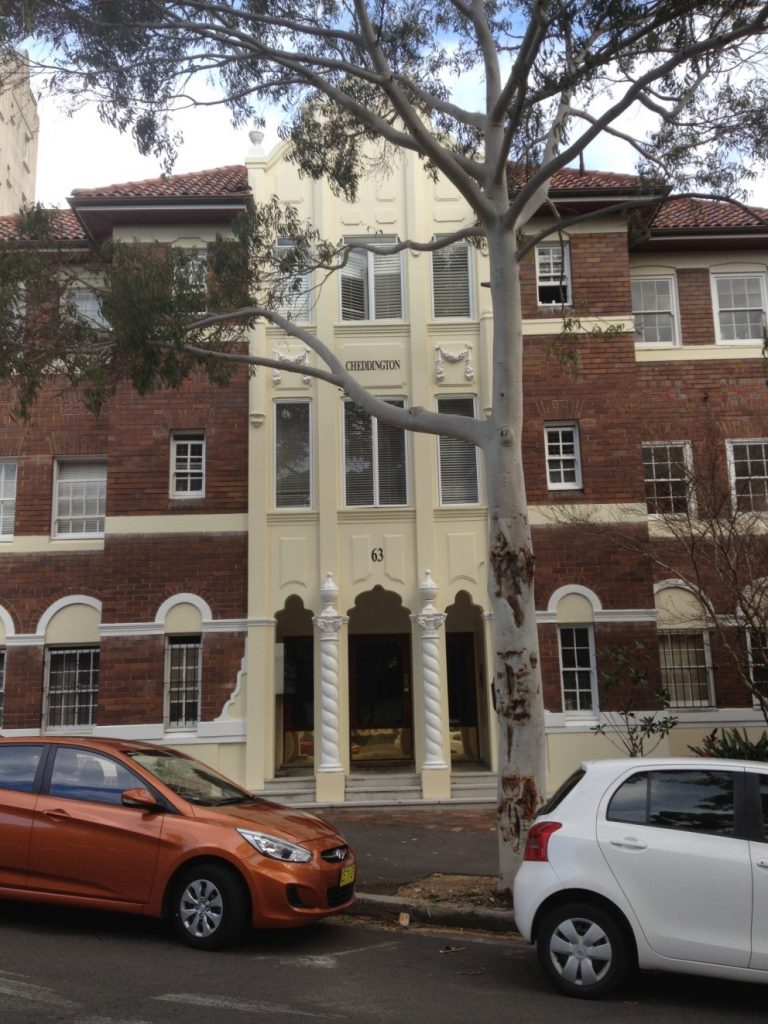ROCKLEY, A SKUNK AND CHEDDINGTON

After Alexander Macleay’s famous 54-hectare estate in Elizabeth Bay was subdivided, a number of one-hectare blocks were created including Tresco, 95 Elizabeth Bay, still on its original block.
An old Carob tree from Macleay’s famous gardens still exists on the Tresco site as do other plantings in today’s Macleay Reserve.
A hand-drawn pencil sketch dated 31st September 1895 in the Mitchell Library shows a double-width block marked “Rockley,” with neighbouring blocks marked ““Ercildoune” and “Eastbourne”, all now demolished.
“Rockley” was built in the nineteenth century as a grand mansion/villa with extensive views both east and west. Its occupants were the prestigious and famous Mr and Mrs Guy Boucher. Mrs Boucher was active in society’s upper social echelon and known for her haute couture.
She was at an important wedding in 1913 where she wore “a costume of black charmeuse with an overdress of Irish champagne lace trimmed with velvet and a Lancer plume.”
She also attended a fashionable wedding at St Marks Darling Point in June 1919 according to the Telegraph’s “Gossip from Sydney”.
The Sydney Mail of September 1923 notes there was a “large party at the Wentworth Café … among the guests was Mrs Guy Boucher”.
The June 1925 Evening News reported in their column “Lady Mayoress Ball – Brilliant” that after the Vice-Regal party, Lady Mayoress and debutantes , ”Mrs Guy Boucher wore black crepe …”.
The Sydney Morning Herald noted that on September 12, 1927 “The marriage was quietly celebrated at St. Marks’ Church, Darling Point … by Canon Howard Lea, of Miss Marcia Evelyn Williams, daughter of the late Evan James Williams, and of Mrs. Guy Boucher, Rockley, Elizabeth Bay, to Mr. Trayton Elliott … The bride wore a frock of blue silk, with hand painted panels … After the ceremony, Mrs. Boucher entertained at the Hotel Australia. Her frock was of black mariette embroidered in gold, and with it she wore a purple hat. The bride travelled in a navy mariette frock, and sealskin jacket trimmed with skunk fur. The honeymoon Is being spent in a motor tour of the mountains.”
Skunk was more luxurious than mink in its day.
Rockley was later sold. The Sydney Morning Herald of 15th August, 1874, advised that “Messrs. Richardson and Wrench sold by auction to-day the following properties: Rockley House and grounds, about 1 acre in, extent, Elizabeth Bay Estate, Darlinghurst, lease-hold, £2450.”
The site was then sub-divided.
Cheddington was later built on the former Rockley site in 1930 and designed by famous architect, Emil Sodersteen (1899-1961). It was part of a movement of inner city high-rise living in the 1930s.
Sodersteen, originally of Swedish heritage, also designed other landmarks nearby including Werrington (1930), 7 Manning Street, Twenty (1930), 20 Macleay Street, Birtley Towers (1934), 8 Birtley Place, Marlborough Hall (1938), 4 Ward Avenue and CBD apartments at 7 Elizabeth Street.
And he was also famous for his commercial buildings including The City Mutual Life (CML) Building (1936), Hunter and Bligh Street, Sydney and the QBE Building (1939-40) (formerly Bryant House) at 80 Pitt Street, both incorporating his jazzy zig-zag window design.
He designed Cheddington before leaving for Europe in 1936. It incorporated various styles of the period. Overseas he was inspired by the modern functional architectural style of Dutch architects Willem Dudock and H. P. Berlage. He was also, not unsurprisingly, impressed by the architecture of Sweden from where his family originated and the taste and culture of the Swedish people. He was not, however, impressed with architecture or quality of workmanship in Britain or America.
After returning to Sydney he adopted a more modernist approach to design. Sodersten changed his name. His esigns changed radically by 1938 after his European trip. His 1938 Marlborough Hall, Ward Avenue, design was in the “style moderne”. The vertical pier on the facade is actually a chimney.
His modernist design for Marlborough Hall (1938) is in stark contrast to Cheddington which incorporated barley twist columns, exotic Moroccan arches and neo-Georgian windows, an amalgam of popular 1930s design themes. It shares its name with small English Bedfordshire village about 80 km north west of London and today remains well cared for in its setting.
By Andrew Woodhouse, Heritage Solutions





